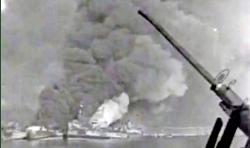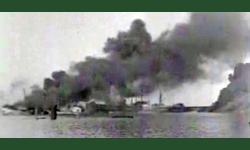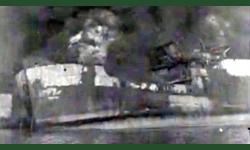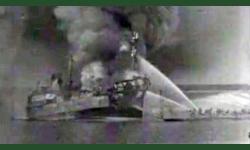
|
The II. Fliegerkorps reported that 105 Ju 88s had taken part (according to Siegfried Radtke 88 bombed and 17 dropped out). Results were assessed as “very good” with four vessels sunk, 21 hit and the destruction of port facilities; this had been achieved at the cost of only two aircraft (see above). The Kriegsmarine’s diary added the significant point that the port was still lit-up as the aircraft approached. As early as 09.50 on the morning after the attack, A/Cdr. Cross signalled MACAF (Mediterranean Allied Coastal Air Force): Our system OK but low approach of raid meant short warning and heavy window put control practically out of action. He also advised that the stand-in Sector Commander was inexperienced and—presumably foreseeing another attack—proposed that an officer of proven ability be loaned during the regular post-holder’s illness. Ten minutes after this message, a Ju 88 took off from Perugia (home of 2.(F)/122) to photograph Bari but it landed at 13.30 having found it impossible to get any pictures. That afternoon, representatives of the British armed services convened at the HQ of 62 Anti-Aircraft Brigade to discuss how the warning services and defences had functioned, G/C Rhys-Jones (No. 286 Wing, RAF) describing the attack as “the best and most cleverly executed raid yet experienced”. GCI had plotted three individual aircraft around 40 km north of the harbour but these contacts were not enough to start a track and indications of Düppel followed right afterward. The situation was complicated in that earlier electrical interference had caused similar responses and furthermore a force of Halifaxes was on its way back from an operation at the time. This meant that the radar responses were not immediately recognised as hostile. Therefore at 19.17 the plot was classed as “doubtful”, then changed to “hostile” eight minutes later. It was later established that the three aircraft had come in very low and started releasing chaff just after they were detected. On the night of the raid, the line between Bari’s Gun Operations Room (which controlled the city’s defences) and the Sector Control Room in Grottaglie (which passed warnings from radar stations) had been out of action. Thus no information arrived through that route nor via the civil telephone system which was used as a back-up. The GOR was however listening in on the line between the Sector and the GCI station, hearing that the latter had a lot of responses on its scopes but could develop no plots: just what Düppel was meant to achieve. Bari considered this enough to issue, at 19.20, a Red warning to the guns which almost coincided with a plot from a gun-laying (GL) radar which was not unduly troubled by the Düppel. The Royal Navy was alerted by telephone but later said that it only received the alert as the guns started firing. The Navy had not gone to Red status because they did not normally do so until three-plus hostiles had been plotted within 40 miles (65 km). This was to prevent the work of the port being needlessly interrupted but on this occasion the Operations Room’s information was not that definite. It appears also that the the Army’s 1979 Pioneer Smoke Company was not ordered into action. Examined afterward, GL plots showed that two aircraft had circled about 15.5 km from the harbour before being joined by two more: “All four then came in and adopted the usual ‘Leader’ tactics”. They were followed by an estimated 20 aircraft at altitudes between 1500 and 3350 m, from which they made repeated dive attacks on the harbour. There was uncertainty over this number since it was thought that, like the pathfinders, the main force had been using chaff. Added to that, few if any of the bombers had flown over land at all, having approached from the North. The defences’ problems were compounded by the attack developing just after Allied fighters had landed from dusk patrol. RAF Signals Intelligence too formed a picture of the raid which it described as “far more successful than any of the four attacks by units based in North Italy against Naples during November.” A dispute seems to have developed between the RAF and the Navy in the wake of the attack, A/Cdr. Cross signalling Flag Officer Taranto and Adriatic, Rear Adm. Rhoderick McGrigor on 5 December as follows: Red Warning given by GOR [Gun Operations Room] to guns similar information to Navy Bari who did not consider information adequate to issue Naval Red warning. Must repeat must emphasise that main cause of widespread damage was … lack of dispersal of overcrowded shipping Bari harbour and not repeat not failure of air defences. One hit on ammunition ship immediately involved four others, one of which later exploded involving remainder of ships. For his part, McGrigor ordered that: Until satisfactory communications have been installed [with the warning network] a Naval Red warning and smoke must be ordered on any unconfirmed report of Windows [sic] or doubtful aircraft … we cannot risk another raid on an illuminated port. The Allies remained nervous, as Jack Farley, air-gunner in a Wellington of No. 221 Squadron, recounted for the BBC People’s War project: One day as we were crossing the Adriatic Sea I noticed two large exhausts of an aircraft dead astern which I quickly identified as a Beaufighter … The next few seconds though, I could not believe my eyes. The night-fighter had lowered his flaps and opened up with four cannons and six machine guns. I did not return fire because I assumed the Beaufighter would soon realise he was attacking a friendly Wellington bomber, not a German aircraft … we had aleady fired the colours of the day and our bomber was also fitted with IFF … A few moments later, however, and [he] returned for a second attack … somehow we managed to stay up in the air … and we eventually made it to Grottaglie … with cannon shells through the props, no port wheel, part of the port wing and main fuselage shot away and a broken air speed indicator … [A] court of enquiry was held. The Beaufighter crew had assumed that our Wellington had been captured by the Germans and was about to attack a target in Italy. For the Germans had recently made a surprise attack on Allied shipping at the Port of Bari on the Italian coast and had sunk over forty ships. continued on next page …
|
||||||
PART FOUR OF SIX © Nick Beale 2019–2022 |
|||||||
|
|||||||




